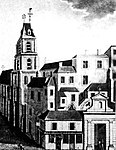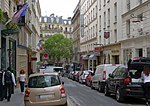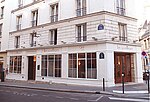Rue Saint-Jacques, Paris
The Rue Saint-Jacques is a street in the Latin Quarter of Paris which lies along the cardo of Roman Lutetia. The Boulevard Saint-Michel, driven through this old quarter of Paris by Baron Haussmann, relegated the roughly parallel rue Saint-Jacques to a backstreet, but it was a main axial road of medieval Paris, as the buildings that still front it attest. It was the starting point for pilgrims leaving Paris to make their way along the chemin de St-Jacques that led eventually to Santiago de Compostela. The Paris base of the Dominican Order was established in 1218 under the leadership of Pierre Seilhan (or Seila) in the Chapelle Saint-Jacques, close to the Porte Saint-Jacques, on this street; this is why the Dominicans were called Jacobins in Paris. Thus the street's name is indirectly responsible for the Jacobin Club in the French Revolution getting that name (being based in a former Jacobin monastery, itself located elsewhere). Johann Heynlin and Guillaume Fichet established the first printing press in France, briefly at the Sorbonne and then on this street, in the 1470s. The second printers in Paris were Peter Kayser and Johann Stohl at the sign of the Soleil d'Or in the Rue Saint-Jacques, from 1473. The proximity of the Sorbonne led many later booksellers and printers to set up shop here also.
Excerpt from the Wikipedia article Rue Saint-Jacques, Paris (License: CC BY-SA 3.0, Authors).Rue Saint-Jacques, Paris
Rue Saint-Jacques, Paris 5th Arrondissement (Paris)
Geographical coordinates (GPS) Address Website Nearby Places Show on map
Geographical coordinates (GPS)
| Latitude | Longitude |
|---|---|
| N 48.846666666667 ° | E 2.3433333333333 ° |
Address
Jacques Gabay
Rue Saint-Jacques 151 bis
75005 Paris, 5th Arrondissement (Paris)
Ile-de-France, France
Open on Google Maps







